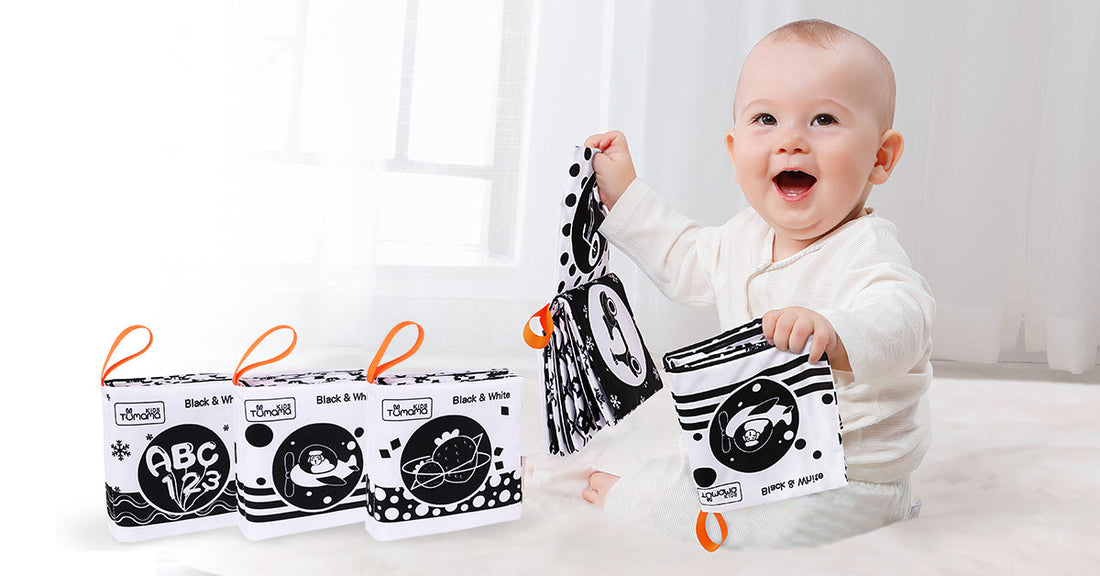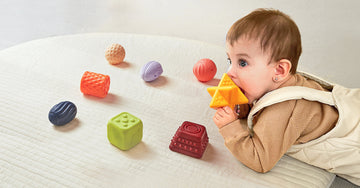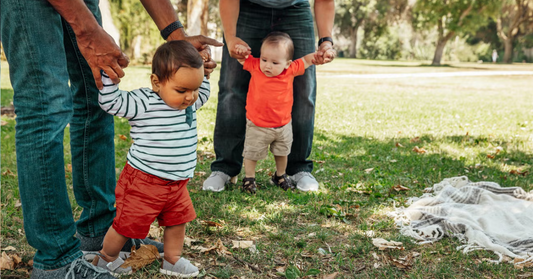Why are high contrast toys good for newborns?

Newborns have underdeveloped vision, but high contrast toys can catch their attention and help stimulate early visual growth.
High contrast toys—especially those with bold black-and-white patterns—encourage babies to focus, track movement, and develop retinal and neural connections. These visual cues help nurture cognitive and sensory development from the earliest days of life.
Let’s explore why these toys are so beneficial and when you should start using them.
What Are High Contrast Toys and How Do They Work?
Parents of newborns may be unfamiliar with what high contrast toys are. Simply put, these toys feature black-and-white or other starkly opposing color combinations. Because newborns can't yet perceive soft colors or complex shapes, bold contrast is easiest for them to see.
Why it matters:
High contrast toys attract attention with bright, simplified patterns that promote eye focus and visual tracking—skills that are essential for vision development.
Key benefits:
- Capture attention easily: The bold visuals stand out in a newborn's blurry world.
- Promote early vision training: Babies learn to follow movement and strengthen eye muscles.
- Stimulate neural activity: Strong contrast signals activate the retina and optic nerve, supporting brain development.
Why Do Newborns Respond Better to Black and White Toys?
You may wonder why your baby seems more fascinated with black and white objects than colorful toys. That’s because their eyes aren’t ready to detect colors yet.
The science behind it:
At birth, cone cells (which detect color) in a baby’s eyes are still developing, but rod cells (which detect light and dark) are more functional. That’s why high contrast, especially black and white, is easier for babies to perceive.
Key takeaways:
- Immature cone cells: Bright colors mean little to a newborn, while bold contrasts make a big impression.
- More responsive rods: Black-and-white images appear more vivid to early vision.
- Better attention span: Even at 2 months, when babies begin to recognize some colors, black and white patterns still hold their gaze longer.
How Do High Contrast Toys Support Visual Development?
These toys do more than grab attention—they actively shape your baby's visual system.
Why it matters:
Visual stimulation encourages retinal and neural development, strengthening pathways between the eyes and the brain. As babies follow and focus on patterns, they exercise key skills like tracking, coordination, and depth perception.
Visual development perks:
- Boost retinal activity: High contrast patterns send powerful signals that energize visual neurons.
- Enhance eye tracking: Toys encourage babies to move their eyes side to side, developing motor control.
- Train binocular vision: Watching high contrast toys with both eyes teaches babies to coordinate their visual input.
Can High Contrast Toys Help with Brain Development Too?
Yes—what babies see affects how their brains grow. The brain’s visual centers rely on input to develop healthy connections.
Why it matters:
Strong visual stimuli create stronger brain wiring. Black-and-white toys help babies form neural circuits for perception, memory, and focus.
Neurodevelopmental advantages:
- Build synaptic connections: Active looking fuels growth in areas of the brain related to vision and learning.
- Encourage cognitive engagement: These toys spark curiosity and drive mental exploration.
- Lay the foundation for later learning: Babies who are visually stimulated tend to be more alert and better prepared for future milestones.
When Should You Start Using High Contrast Toys?
You can start using high contrast toys almost immediately after birth.
Why it matters:
Newborns can only see about 8–12 inches away and are drawn to sharp contrasts. Early visual engagement helps babies become more responsive and attentive.
Timing tips:
- From day one: Hold a toy about 10–12 inches from your baby’s face during alert moments.
- Keep using them through 3 months: Babies rely heavily on black-and-white cues during this stage.
- Gradually increase distance: As vision improves, you can present toys at 16–20 inches around 3–4 months.
Are High Contrast Toys Better Than Colorful Toys for Young Babies?
In the early months, yes. Colorful toys may seem attractive to parents, but they don’t engage newborns as effectively as bold black-and-white designs.
Why it matters:
Color perception comes later—usually around 3–5 months. Until then, babies see color as shades of gray, making contrast toys far more stimulating.
Age-based comparison:
- 0–2 months: High contrast toys are crucial for visual stimulation.
- 3–5 months: Babies begin to detect red and green, but black and white remains more engaging.
- 5+ months: Brightly colored toys become more effective, but contrast toys are still useful for focused play.
What Are the Best High Contrast Toys for Newborns? (Tumama Kids Picks)
If you’re looking for effective high contrast toys, Tumama Kids offers a wide variety designed to support newborn visual development.
Why parents love them:
Tumama Kids uses bold black-and-white designs and baby-safe materials to help babies focus and grow. As noted on their tumama-kids.com, these toys “enhance visual tracking and attention.”
Top product picks:
- Black-and-white hanging toy sets: Cute animal rattles that attach to strollers or cribs to keep babies visually engaged.
- High contrast soft cloth books: Durable books filled with patterns, textures, and baby-safe mirrors for visual exploration.
- Flashcards for visual stimulation: Great for tummy time or quiet play, these cards provide eye-catching graphics to support focus.
- Baby play gyms with contrast patterns: Encourage reaching, coordination, and visual tracking with safe, adjustable frames.
Each high contrast baby toys is designed with both education and safety in mind, offering the perfect combination for newborn development.
Conclusion
High contrast toys are more than just visually striking—they’re essential tools for newborn growth. By providing strong visual stimulation during the critical early months, these toys help shape your baby’s ability to see, think, and learn.







0 comments